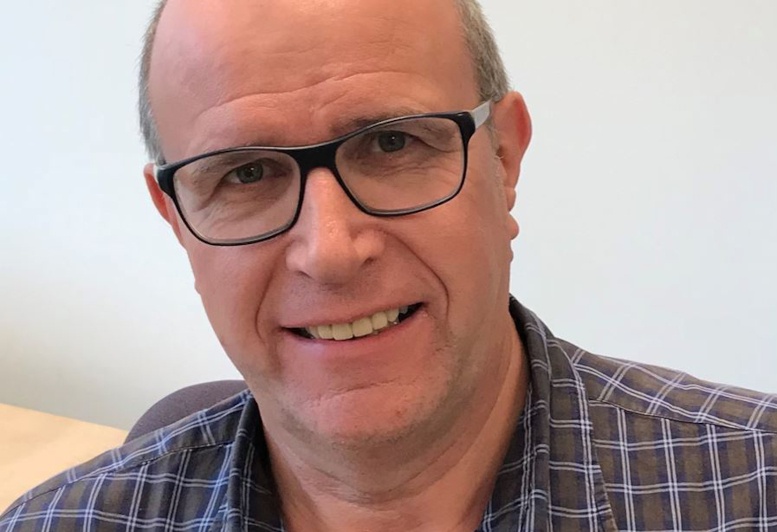INTERVIEW: Dirk Van Puyvelde is co-owner and technical and innovation manager at the Belgian companies Cretes (CREative TEchnical Solutions), a maker of straw and fiber processing machines, and Union NV SA, which makes flax harvesting technology. Both are divisions of Belgium’s ValTech engineering group.
HempToday: Can you just give us an overview description of the end-to-end technology needed for hemp textile production?
DVP: It’s important to understand that the use of hemp for textiles can be divided in two different ways. Simplified we could name them the “cotton way” and the “flax way”. To replace cotton and synthetic fibers, or to be blended with them, hemp should have the same appearance, length and fineness. Technologies for realizing this — harvesting, retting, baling, decortication, refining and cottonization – already exist. For the “flax way,” once hemp is harvested correctly, the whole chain of the flax industry can be used for hemp.
HT: So the harvesting is critical.
DVP: To imbed hemp as an extension of the high-end segment of flax textile (linen), there has always been the difficult obstacle of the harvesting method. The properties of hemp fiber are very similar to those of flax. But there is one big difference: Flax grows to about 1 meter in height, while hemp grows over 2 meters. Until now, this made it difficult to harvest hemp the same way flax is harvested. To go through the flax processing chain, hemp must be harvested in parallel swaths of stems, cut to a length of about 1 meter.
HT: Tell us about the harvesting solution you developed to address that challenge.
DVP: In cooperation with La Chanvrière (France), Cretes knocked down this wall, and developed and tested the “missing” harvesting machine. Our harvester is adaptable to plant growing height. It cuts the stem into two parts roughly 90 centimeters in length. It also removes the roots and the top stem parts with the leaves and flowers. The stem parts are laid on the ground in perfectly parallel and nicely separated swaths, waiting for retting. This will undeniably lead to wonderful scutching results. In a further variant plant tops can be harvested for CBD production.
HT: In addition to La Chanvrière, Cretes cooperated with Union in developing the new harvesting technology. What were the project partners’ contributions to that process? How did the cooperation function?
DVP: Cretes specializes in developing and building machines. La Chanvrière is the European leader in hemp cultivation, hemp fiber processing and commercialization of hemp products. Cooperation with La Chanvrière puts us directly with both legs into the world of hemp and provides us with everything needed to go far beyond machine construction.
Union is our sister company within the Valtech Group. The importance of Union is double. Its specific knowledge concerning flax harvesting machines was a great help in developing the hemp harvester, and this will become even more important once we proceed to serial production. On the other hand, Union is well-known in the flax industry and an appreciated machine supplier to almost every flax grower. I am convinced that especially in Europe, the success of hemp for textiles will be linked to the flax industry.
HT: What’s the status of that technology’s development?
DVP: Although many acres are already baled, waiting for scutching, and despite the huge pressure of potential customers, we decided to use the next harvest season to make our machine mature and ready to conquer the market starting 2023.
HT: How important will sales of the hemp harvester be to your overall business?
DVP: The hemp harvester will become an important diversification of Union’s portfolio. Cretes’ core business is flax and hemp fiber processing. The growing worldwide hemp business will lead to a growing market for fiber processing. As always, Cretes will be on the front line to develop new technologies for its customers.
HT: How would you describe the demand for your hemp-specific technology? What kind of machinery seems most in demand at the moment?
DVP: Summarized, every aspect of hemp fiber seems hot at the moment.
HT: Cretes has an interesting assortment of sister companies making specialized equipment. Talk about the importance of those companies in your approach to engineering.
DVP: Indeed, we have a lot of sister companies within the Valtech Group. What we have in common is the development of technology for customers in the sustainable, renewable, and circular economy. Our pool of 150 engineers in Valtech Group provides us with tremendous experience and know-how.
HT: Tell us a bit about your overall customer base, and how far it extends.
DVP: Until now, our customers were mostly based in the European flax and hemp sectors but nowadays interest in hemp seems to come from all over the world, especially from the U.S. and Canada.
HT: What’s your overall assessment of how the hemp fiber industry will grow?
DVP: Hemp has everything to become by far the most environmentally friendly fiber in the world. We’ve believed in it for many years, and now we are glad it finally has started. It surely can’t be stopped. We are convinced there will be a wealth of new products that will be developed based on hemp.

